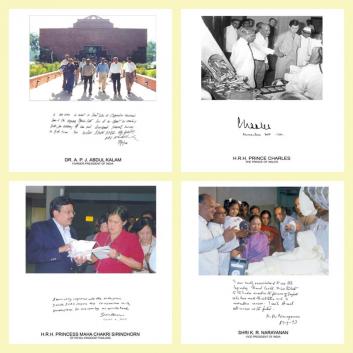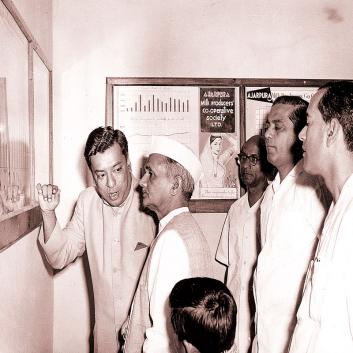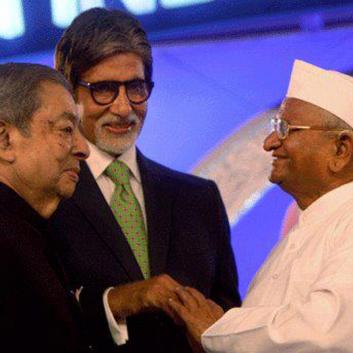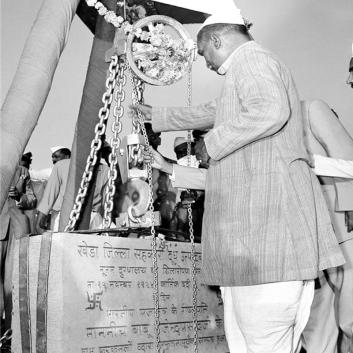All India Women’s Conference
All India Women’s Conference
World Food Day : “Women and Food”
New Delhi, 17th October, 1981
Operation Flood II and the role of
women in dairy development
by V Kurien
National Dairy Development Board
Anand 388 001
Operaticn Flood II and the role of women in dairy development
Madam President, Office Bearers and members of the All India Women's conference, honoured guests.
It
is a double honour for me that I should have been invited to deliver
this address: firstly,
because this meeting is taking place to
observe the World Food Day -
and
secondly, because my colleagues and I do attach great importance to
the role of women in
dairy
development, which ·is my topic today.
I would like to start by inviting you to travel back in time with me, to the late 1940's and early 1950's, when I first went by chance to the small town, Anand, in Gujarat. The Kaira District Co-operative Milk Producers' Union ("Amul") had barely come into existence then; Anand itself was little more than a village with a railway station - and the district of Kaira had no all-weather roads. Moreover, in those days, in the most progressive community of the area, infanticide was quite common, daughters were a liability to be avoided if possible. A father could not dandle his daughter on his knee. If the family was fortunate enough to produce milk for their own consumption, a share of it would go to the boy-children, but not to the daughters.
Only 30 years ago, that was the situation in Kaira District. It is good to recall this, if only to think how far we have come during these past 30 years. Today, we have adivasi women employed as trained artificial inseminators of milch animals; we have a few village milk cooperatives with women as office bearers and managing committee members - and, in effect, the Kaira District's vast business of milk production is handled by women, who also get the money directly which they earn from the fruits of their labour by selling milk to their village milk co-operatives.
We
still have far to go, no doubt, but we should not belittle the
advances which have been
achieved over these 30 years. After all,
30 years is equal to only a breathing space in the lifetime of a
society. Also, if we have been able to come so far in the first 30
years of independent India's life, can we not reasonably expect to
achieve far higher goals during the coming 30 years?
Today, however, I want to talk - about dairy development, and women, not only in the role of rural milk producers, but also as urban milk consumers. Both roles are vital in the modernisation of our dairying - and that modernisation can also be a boon to women, in their roles of both milk producers and also milk consumers.
The urban milk consumers of India have been misled and manipulated by generations of bureaucrats, politicians and self-styled leaders. This is why so many dairy development schemes for urban milk supply have collapsed. After all, it is well known what usually goes wrong with an urban milk scheme. It purchases milk, pasteurises it, bottles it, keeps it cold… and yet, that milk is sold at prices lower than those charged for unpasteurised, un- packaged milk. Inevitably, the scheme runs out of milk and of money - and the only solutions offered by whatever government runs these dairies are, in effect, subsidies (which go to urban consumers, rather than to rural producers).
When this state of affairs reaches a peak, ghee prices start shooting up (as is happening at present) - and the urban milk scheme can no longer pay a competitive price for milk. Then Government has only two alternatives: either, it must pay out the mounting losses of the milk scheme, or it must abandon its social objectives, such as making milk more readily available to weaker sections of the community, and put up the retail price of milk.
Whichever decision is made, the administrators responsible will be in the soup !
It was in order to break this disastrous cycle that we at the National Dairy Development Board evolved Operation Flood as we did. We said, in effect, let us take the best urban milk markets and the best rural milksheds - and then get the milk from the milksheds flowing to the major metro cities in an orderly, stable and economic system. We were confident that, if we could get this basic milk marketing system stabilised, then the modernisation of the rest of our dairy industry could proceed in an orderly manner.
There
were many difficulties along the way, one of which centered on this
august city of Delhi. For it was in Delhi that we determined that a
new system of milk retailing should be
demonstrated first in
India. I refer, of course, to the Mother Dairy's system of
bulk-vended milk. When Operation Flood started, in 1970, we had
recommended that the first 200 bulk-vending units should
be imported from America, where only they were at that time in
manufacture for use in Mexico. Several years went by, but we were not
allowed to import these machines -
and,
in any case, we were told that bulk-vending could never be successful
in India, that the milk will be diluted that the machinery can never
be maintained etc ... such was the confidence which our Government
Officials had in our modern dairy managers and technically qualified
personnel !
The
decision makers then turned down the whole idea of importing the
machines and told
the National Dairy Development Board that if it
wanted bulk milk vending it should design and
manufacture its own
bulk-vending system. Considering that they had thought that not even
an
imported bulk-vending system could be made to work in India,
you can well imagine the confidence with which they foresaw the Dairy
Board falling flat on its face, should it be stupid enough to try to
design its own
bulk-vending system !
In brief, the NDDB was "set up" - we were to be the "fall guys" !
In the event, however, we were able to design and get built a wholly indigenous bulk-vending milk system. Today, some 30% of the city's milk is retailed through that system and many consumers have thanked the NDDB for its role in this development.
Now,
however, all could be threatened. Consumers, especially the women who
have to manage their household's economy, could be manipulated into
ensuring the destruction of systems like the Mother Dairy's
bulk-vending milk system. As you must be aware, the price of ghee has
been manipulated upward to levels at which milk traders can penetrate
the rural milksheds where the cooperatives procure milk for the
Mother Dairy, the Delhi Milk Scheme etc. Thanks to the
ever-escalating ghee price, these traders are able to offer higher
prices for milk than can the cooperatives which are selling milk to
the Mother Dairy
and the Delhi Milk Scheme. In this situation,
how can we get milk for the Mother Dairy or the Delhi Milk Scheme,
when the price charged to consumers does not enable us to offer
competitive prices to rural milk producers ? Once again, we shall be
damned if we put up the price and damned if we don't, because if we
don't, there will be little milk available either to the Mother Dairy
or the Delhi Milk Scheme for the citizens of Delhi -
and
if we
do ... well, every-one dislikes rising prices !
Allow
me to take another, more controversial aspect of women's role in
dairy development, especially as it applies in India: namely, the
question of "baby food," or "infant milk foods."
In the early 1950's, the Government of India asked Amul to undertake
the manufacture of infant milk foods, because they were being
imported into the country by multinational manufacturers, who had
told the Government that they could not manufacture
such
"sensitive" products in India, apparently only because our
air was "too dirty" etc.
So, Amul undertook the manufacture of infant milk foods - and, subsequently, the multinationals found that, after all, it was possible to manufacture these sensitive products in India. Since then, by its policies of direct purchase of milk from farmers, the most stringent quality control - and least-cost marketing - Amul has captured the largest share of this market in India, despite the best efforts of the multinationals (who, incidentally, put a far higher proportion of their sales income into promotion than does Amul).
Now, into this picture, comes an organisation called "WHO." I do not know who is in WHO, but apparently they are telling us that, after all, infant milk foods are a bad thing and that they should be stopped and their advertising banned. Many women's organisations, I understand, support this effort of WHO.
Now,
all of us are aware of the advantages of breast feeding -
including
the professionals in organisations like Amul. In any case, there is
no time on this occasion to detail all the
advantages of breast
feeding and the physiological and psychological factors which
sometimes prevent or curtail successful breast feeding. But I think I
should list some questions regarding infant milk foods which need
further consideration:
In a country's rural areas where there is no advertising of baby food, such as the People's Republic of China, there is well researched evidence that a significant proportion of mothers are unable to produce enough breast milk for their infants and that doctors believe that supplementary foods for infants are indicated for mothers of these infants.
In any case, in our country, as far as we can tell, not more than 2% of infants are fed with infant milk foods (say, 8-10% of urban infants).
If, as is being suggested, all advertising of these infant milk foods ceased - and they were put on prescription, is it not inevitable that, for the few mothers who need and can afford these foods, the cost of them will simply go up by the cost of getting them on prescription?
In addition, as citizens of an independent and free society, we should perhaps consider the implications of forbidding farmers' organisations access to the media for the purpose of advertising their produce.
Now,
the informed consideration of these complex factors depends, in my
view, largely on
there being a body of women who can advise both
the Government of India and farmers' organisations such as Amul on
how they feel the matter should be dealt with. Certainly, Amul can
cease production of infant milk food production tomorrow morning and
divert the milk to other, more profitable products. But if it does
so, the price of these infant milk foods will go up -
and,
we shall be damned (also, the multinationals will re- enter the
market in a dominant manner, with all the drawbacks which this
implies from a national policy point of view). On the other hand, if
Amul continues to try to make baby food available and to keep mothers
informed as to its availability and its proper usage, it appears that
we shall also be damned.
Again, as is the case with our policy regarding urban milk schemes, it appears that we are damned if we do and damned if we don't. In other words, we are in what our young people call "a Catch 22 situation" - and I am hoping that one of the roles of women in dairy development will be to help get these self-contradictions ironed out !
This
will become all the more important in the next few years. You
probably know that, at the instance of the Government of India, the
NDDB has just started a project to increase the production of
oilseeds and to increase the availability of vegetable oils, while
also attempting to achieve a supply-demand balance which will
stabilise prices. The NDDB has already started to implement its part
of this programme and we do expect a
significant increase in
oilseed production in the areas covered by the project this year.
Meanwhile, the consumer price of vegetable oil has, certainly,
inflated in line with other food prices, but the prices paid to
farmers for their oilseeds have been increased more,
in order to induce an increase in production. This has been done by
achieving a severe reduction in the margins earned by speculators and
middlemen.
In the vegetable oil business, speculators and middlemen are very powerful. We have encountered (and we continue to encounter) many problems, and even violence, on account of the power which these gentlemen wield.
Yet, Government now desires to apply the Operation Flood principles to the production and marketing of fruits, vegetables - and, possibly, even fish.
If we take the example of fruits and vegetables, you may have heard, as I have, that the Delhi market for these kinds of produce is dominated by two or three people who make a lot of money out of it. So, if the NDDB starts to try to get fruits and vegetables marketed directly to you by the producers, without the intervention on middlemen, the quality will rise and the middle-men's margins will fall - and I suppose our professionals working on the project will, yet again, suffer from an anonymous violence.
In
all these cases, I feel that more active support from well informed
consumers, and women's organisations such as the All India Women's
Conference, could actively be brought to bear on the powers that be,
in order to try to construct a situation in which we can more easily
get on with the job of getting rural producers' produce to you in
better condition and more economically, while also ensuring that a
higher proportion of
the urban consumers' food rupees get back to
the producers themselves, thereby ensuring a better supply of food
for urban consumers and their families, as well as bringing certain
benefits to rural producers.
Allow me to turn for a moment to rural producers. In the case of milk, we are largely talking about women - and, even for other crops such as fruits and vegetables, much of the work is often done by women and/or children. I am sure that we would all prefer that child labour should be eliminated, so that children can go to school and develop freely and fully. But this can come about in rural areas only when incomes rise and many old traditions adapt to the imperatives of modernisation.
I
have worked as a professional manager for rural producers for some 30
years. It is a
mistake to think that rural people need to be told
what is good for them. They -
including,
especially, the women -
know
what is good for them and their families. At most, they sometimes
need to be shown (or, they need to have a proof)
that
our urbanised professional elite is genuinely willing to put the
tools of modernisation into rural people's hands.
For
example, take the controversial question of turning our unproductive,
nondescript cattle
into cows crossbred with Western breeds such
as Jersey -cows. Such crossbreds are more productive and more
profitable to keep. But one reaction to this approach to cattle
breeding is that it
will-"replace women" in milk
production, even though I am told that many European women, for
example, manage 100% Jersey cows as successfully as the men (if
not more so).
But, I put it to you that in any family living in a village, a man and a woman will sort this out. In any case, development is difficult enough to do with-men - and we, the urbanised elite, are trying to tell families and villages how to manage their male-female relationships? In all walks of life, men and women have to find how to manage the process of development together. When urban people are trying to tell rural people how to tackle it, it often looks to rural people as if this is yet another case of the urbanised elite justifying its existence by concentrating one telling others what to do, when they cannot even manage their own development properly.
Instead of these patronizing, rhetorical approaches to "rural development," it would be more helpful to both rural women, and also rural men, if urban women (especially those from better-off families) would think a little more about the impact of their actions on rural people. I mentioned, for example, a little earlier, that the price of ghee has gone out of control. I am told that ghee is selling for Rs 50 per kilo in Bombay. Every kilo of ghee purchased at such a price means the loss of probably some 25 litres of milk from the co-operatives' milk supply to cities like Bombay and Delhi - and the milk schemes could compete against the ghee merchants for that milk only if buffalow milk were to sell at Rs 5-6 per litre in Bombay and Delhi !
I wonder how many urban consumers, who can afford to spend Rs 50 on a kilo of ghee, stop to think, before they pay such prices, of the impact which this action will have first on their own pockets - but also on the well-being of rural producers ?
After
all, for every woman who is responsible for feeding a family in an
urban area, there are four such women in our villages, almost all of
them far worse off than their urban counterparts. For those rural
families who are milk producers depending on our milk co-operatives
for daily income, if the ghee merchants smash the co-operative
system, the milk trade will revert to the jungle -
and
the rural milk producers will once more be at the mercy of
money-lenders and middle- men. So, I suggest, the first thought that
an
urban woman can have, on her role in dairy development, is to
think of her four sisters in
the villages, who may yet be driven
back into the grip of middlemen and money-lenders, if the
co-operative system is not there to protect them.
The
implications of this are far wider than just "milk" or
"fruits and vegetables." After
all, the introduction of
Anand Pattern Co-operatives into villages does not only affect the
marketing of produce as such. For example, when a milk
co-operative starts in a village, the co-operative's veterinary
doctors come to attend the animals. Women learn about the artificial
insemination of animals. They see for the first time live semen under
a microscope. They learn about the reproductive process and how it
can be controlled.
In
other words, "development" is not merely increase of
production of milk, or fruits, or
vegetables -
it
is an exposure to modernity, and access to modern science and
technology, right in the village itself.
Indeed, we now have a pilot programme which is beginning to indicate that the Anand Pattern Co-operatives can actually provide an infrastructure on which each village, as a whole, can build its own welfare programme according to its priorities, including provision of maternal health-care, supplementary feeding for needy infants, village youth employment and environmental sanitation. In this pilot programme, the women of the villages covered are taking a lead and using the Anand Pattern Co-operative's infrastructure for making the community decisions required, for coming to a cons census on the villages' priorities and on the vital function of selecting village women for training as Village Health-Care Workers and so on.
Again,
I reiterate, there is evidence that these women need not be told by
the urban elite
how to achieve their objectives for their
families -
they
only need to be allowed to get on with the job.
But all these changes cannot take place if urban women, in their role as consumers, do not do their bit toward helping to see that their rural sisters (the "other 4") are genuinely helped to reap the fruits of their labours. Indeed, the time is coming when informed urban women can and should insist that the milk which they are supplied for their families comes from rural co-operatives - and that a fair price is paid for that milk, directly to the producers - and this movement should march on from milk to fruits, from fruits to vegetables - and who knows: the day must surely come when all rurally produced foodstuffs (not to mention cotton and jute, also) will be properly marketed, and fairly prices, for both producers and consumers.
Then - and only then - can our rural majority (both men and women) at last play their appropriate roles in all forms of development including, of course, dairy development.
Thank you.




